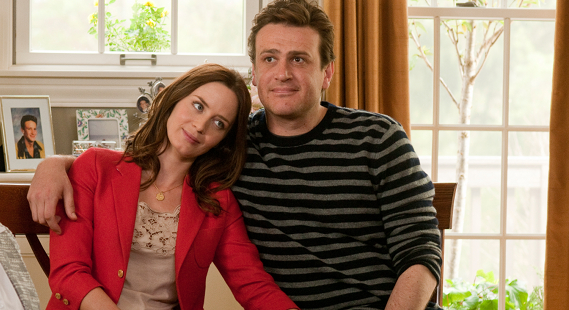Making It Work, by David Bax
The title of Nicholas Stoller’s new film, The Five-Year Engagement, sounds like a high-concept Hollywood comedy. It immediately suggests that there will be one or more contrivances put in place to keep the leads just out of striking distance of matrimonial bliss. On paper, that’s exactly what happens but, in execution, it’s the exact opposite of everything I feared.
We meet Tom (Jason Segel, who also co-wrote) and Violet (Emily Blunt) one year after they met and just minutes before Tom is going to propose. He does and, obviously, she accepts. After that, there is the exciting period of planning and telling the families but it’s not long before circumstances change. Violet gets accepted to graduate school in Michigan and Tom decides to leave his promising job as a San Francisco sous chef and go with her. From there, one obstacle after another keeps the wedding postponed. In the meantime, Tom and Violet evolve and so does their relationship.
What’s refreshing here is the film’s mature honesty about the way long-term couples grow together and apart. Even when the engagement, the marriage and the relationship are at risk, it’s always clear how deeply they care about one another. A person continues to change even after he or she has found the supposed “one.” It’s the level of respect more than the notional compatibility that allows a couple to weather these changes. Yet sometimes that same respect is what leads to an amicable but still crushing break-up. As Tom and Violet progress, it’s the recognizable changes in communication – the way a couple goes from being who they think they should be to knowing each other well enough to anticipate wants and reactions – that keeps us on the edge of our seat. Their non-binding union is both relatable and unpredictable because of its verisimilitude.
Segel and Blunt, to our great benefit, have undeniable chemistry (though considering the similarly charming relationship in last year’s stultifying The Adjustment Bureau, perhaps Blunt would have chemistry with anyone in anything). This is the increasingly rare example of a comedy in which extended improvisation works because it allows us to see how much these two enjoy each other’s company. The heaviest lifting in the humor department, though, is spread out among the astounding and delightful supporting cast. Alison Brie as Violet’s sister and Chris Pratt as Tom’s best friend are outstanding second bananas and the cast includes both comedy professionals – Lauren Weedman, Mindy Kaling, Kevin Hart, Chris Parnell and Brian Posehn (who is the film’s secret weapon) – as well as character actors stretching their comedy muscles – Mimi Kennedy, David Paymer, Jacki Weaver and Rhys Ifans. Cameos from Molly Shannon, Tim Heidecker and hilarious up-and-comer Kumail Nanjiani certainly don’t hurt either.
So stellar are the improvisational chops of the cast that the film actually becomes weakest in its more orchestrated moments. A section in the middle, for instance, where a disillusioned Tom finds solace in becoming a rustic Michigan hunter/gatherer/home-mead-brewer is funny in concept but the make-up and set decoration become overwhelming. The sequence is mostly redeemed, however, by Brie and Pratt’s loose and hilarious riffing.
In the film’s other major transgression, it makes the mistake of not trusting the intelligence of its audience, which is surprising for a movie that is otherwise so mature. There is a motif of doughnuts – some stale and some fresh – the significance of which becomes fairly clearly fleshed out as the story pushes on. It’s a bit insulting, then, when in thethird act, a character essentially explains the metaphor loudly and in great detail. It’s a conspicuously condescending move for a film this apparently sophisticated.
Looking at only the barest facts, you could rightly say that this is a constructed studio romantic comedy. By being so well-observed, though, and by containing the invigoratingly realist message that no two people are ever 100% right for each other, The Five-Year Engagement is in many ways the inverse of every Hollywood movie like it. Also, it’s really funny.






























